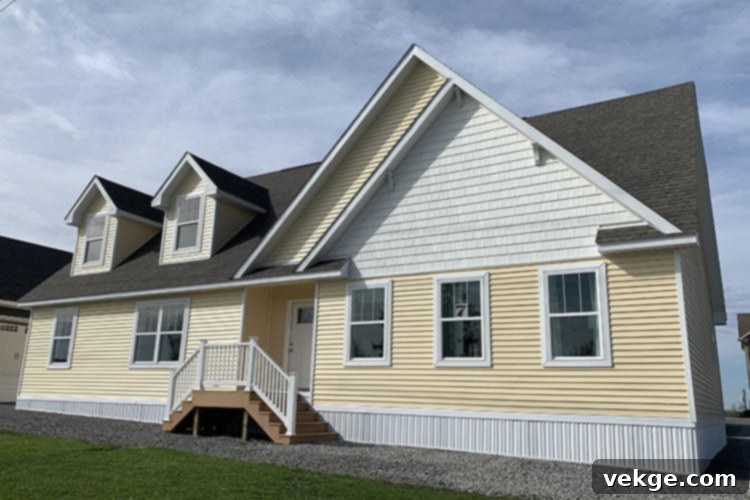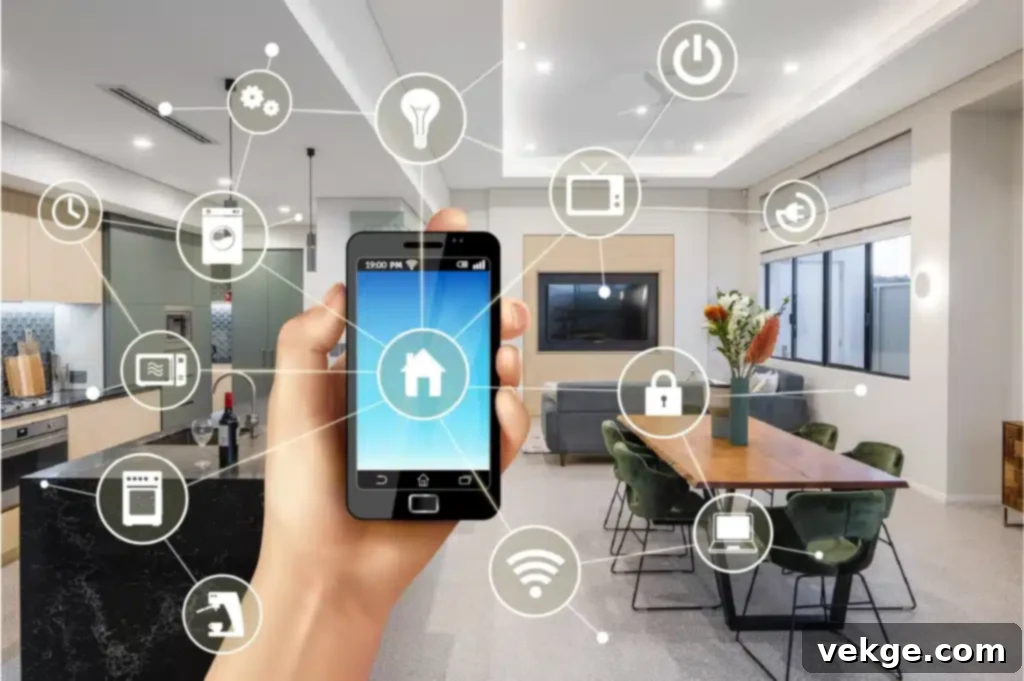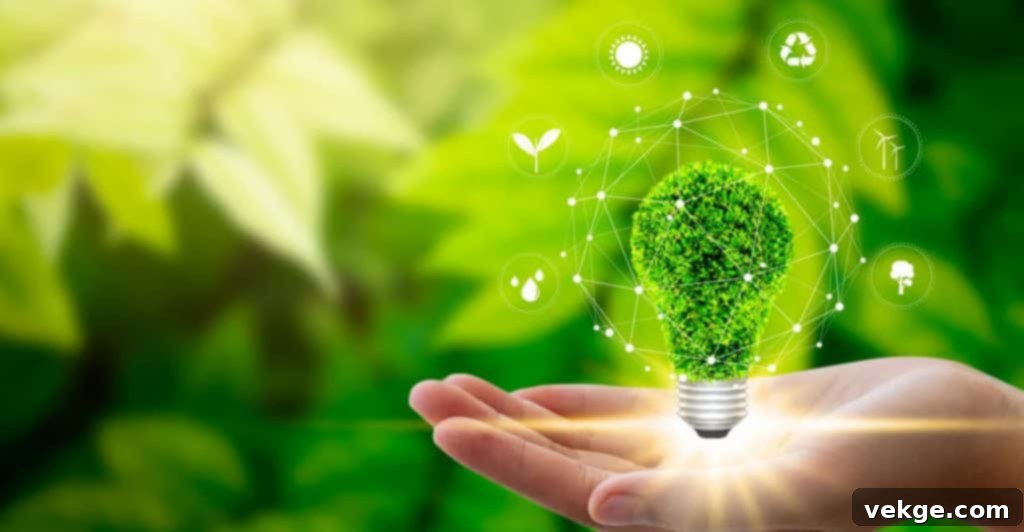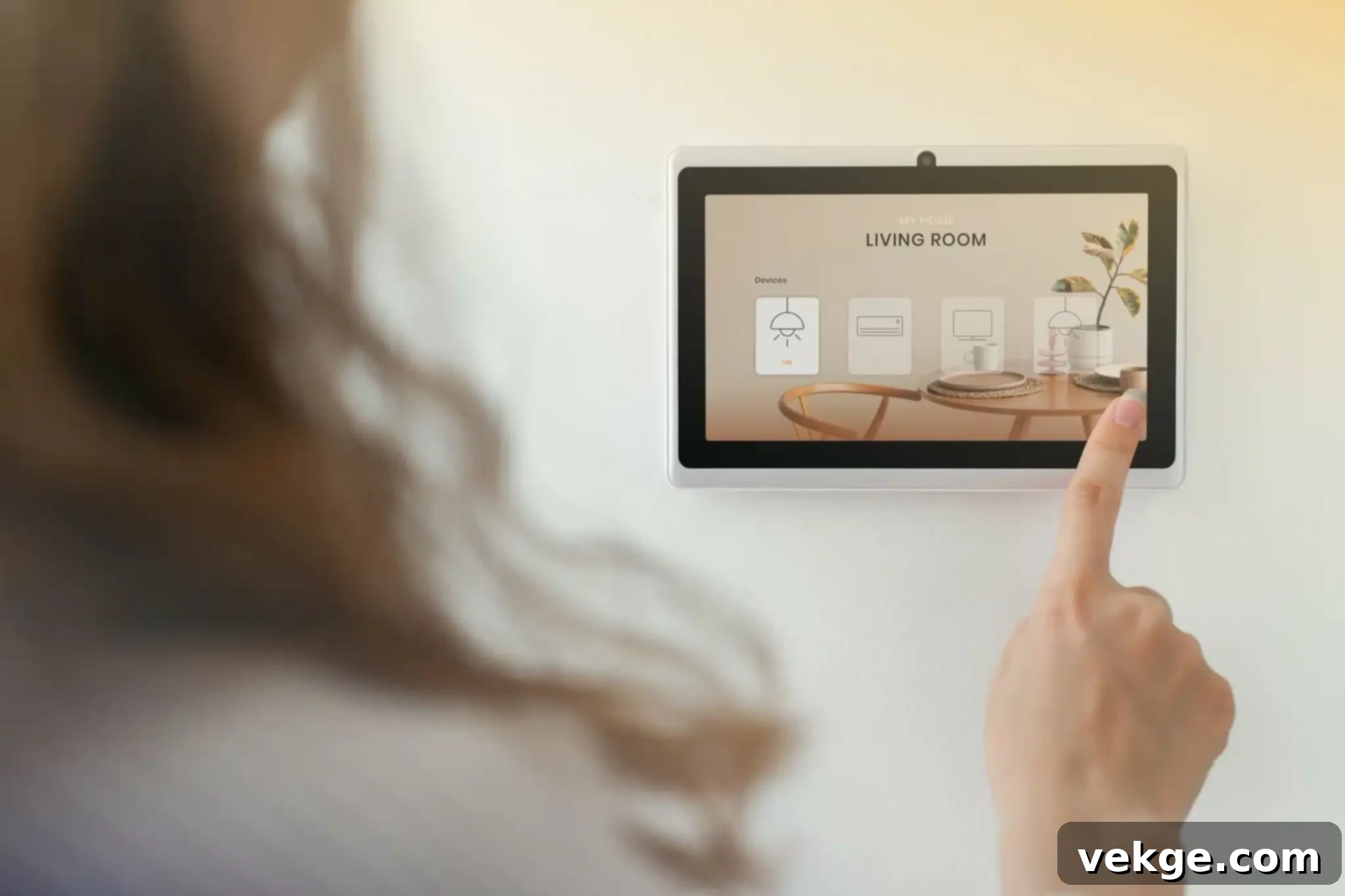Revolutionize Your Home: The Ultimate Guide to Technology-Driven Maintenance for Safety, Efficiency, and Sustainability
In an increasingly digital world, our homes are no longer just physical structures; they are becoming intelligent, interconnected ecosystems that seamlessly integrate with our daily lives. This evolution blurs the lines between traditional home maintenance practices and cutting-edge technological innovation, offering homeowners unprecedented opportunities to enhance comfort, fortify security, and significantly reduce their environmental footprint. Are you leveraging the full potential of these advancements to create a living space that is not only efficient but also a true sanctuary?
This comprehensive guide delves deep into the myriad ways technology is revolutionizing every facet of home ownership. From sophisticated security systems that provide real-time peace of mind to smart home devices that automate daily chores and eco-friendly solutions that drive sustainability, we will explore how modern innovations are reshaping the landscape of home maintenance, making your abode safer, healthier, and more connected than ever before.
Safety Assurance: Fortifying Your Home with Advanced Technology
Ensuring the safety and security of your home and loved ones is paramount. Modern technology offers an array of tools that go far beyond conventional locks and alarms, providing proactive protection and invaluable peace of mind. Navigating home maintenance isn’t solely about keeping your property in good condition; it’s fundamentally about guaranteeing your sanctuary is secure and resilient against potential threats.

Cutting-Edge Security Systems
The landscape of home security has transformed dramatically. Gone are the days of simple alarms that only sound an alert when a breach occurs. Today, you can monitor your home with unprecedented precision, receiving real-time alerts and accessing live video surveillance directly from your smartphone, no matter where you are. These integrated systems offer layers of protection, deterring intruders and providing crucial evidence if an incident occurs. Key features of modern security systems include:
- Smart Motion Sensors: These intelligent sensors instantly detect unusual movement inside or outside your property, differentiating between pets and potential intruders to minimize false alarms. Many can be customized to specific zones or schedules.
- High-Definition (HD) Cameras: Equipped with night vision, wide-angle lenses, and sometimes even facial recognition, these cameras capture crystal-clear footage day or night. Options include indoor, outdoor, doorbell cameras, and even pan-and-tilt models for comprehensive coverage.
- 24/7 Professional Monitoring: For an added layer of security, professional monitoring services ensure that trained personnel are always overseeing your home. In the event of an alarm, they can verify the threat and dispatch emergency services immediately, even when you’re unable to respond.
- Smart Locks and Access Control: Replace traditional keys with smart locks that can be controlled remotely. Grant temporary access to visitors or service providers, receive notifications when doors are unlocked, and ensure all entry points are secured with a tap on your phone.
- Door and Window Sensors: These small, discreet sensors detect when a door or window is opened, triggering an alarm and sending an immediate notification to your device.
- Environmental Sensors: Beyond intrusion, modern security systems often integrate sensors for water leaks, extreme temperatures, or carbon monoxide, providing a holistic view of your home’s well-being.
Advanced Fire Protection Technologies
In the face of a potential fire, every second is critical. Modern fire protection technologies have evolved beyond simple smoke alarms to equip your home with tools that are both responsive and preventative. These systems are designed to detect threats earlier, alert occupants more effectively, and even mitigate damage before emergency services arrive.
- Smart Smoke and Carbon Monoxide Detectors: These devices don’t just sound a loud alarm; they send immediate alerts to your smartphone, wherever you are. Many can also pinpoint the exact location of the smoke or CO, allowing for faster response. Some models even interconnect, so if one detects a problem, all units in the house will sound an alarm.
- Automated Sprinkler Systems: While traditional sprinklers can cause extensive water damage, modern smart sprinkler systems are more sophisticated. They can often activate only in the affected area, minimizing damage to other parts of your home. Some advanced systems can even use thermal imaging to identify heat sources and target water application precisely.
- Integrated Emergency Lighting and Exit Paths: In the event of a fire, smart lighting systems can automatically illuminate escape routes and flash specific lights to guide occupants to safety, especially useful in larger or unfamiliar homes.
- Smart Fire Extinguishers: Though not yet mainstream, concepts for smart fire extinguishers that provide instructions or even automated deployment are on the horizon, further enhancing immediate response capabilities.
Comprehensive Home Health Monitoring
Beyond structural integrity and external threats, maintaining a healthy indoor environment is crucial for the well-being of your family. Technology now offers sophisticated solutions to continuously monitor and improve the quality of your living spaces, addressing unseen hazards that can impact health. This proactive approach ensures your home is not just safe, but also a healthy place to live and thrive.
- Advanced Air Quality Sensors: These devices continuously monitor for a range of indoor pollutants, including Volatile Organic Compounds (VOCs), particulate matter (PM2.5), carbon dioxide (CO2), humidity, and allergens. They provide real-time insights and send alerts if levels become unhealthy, often integrating with smart ventilation systems or air purifiers to automatically improve air quality.
- Intelligent Water Quality Monitoring: Ensure your drinking and bathing water is free from contaminants, heavy metals, and chemicals with real-time analysis systems. These devices can monitor pH levels, hardness, chlorine, and more, alerting you to issues and often integrating with smart filtration systems to maintain optimal water purity.
- Dynamic Noise Level Monitoring: Manage and mitigate noise pollution within your home to create a more peaceful and stress-free environment. Sensors can identify sources of excessive noise, allowing you to take steps to soundproof or adjust activities. This is particularly useful for optimizing sleep environments or home office productivity.
- Mold and Moisture Detection: Smart sensors can detect subtle changes in humidity and temperature that indicate the potential for mold growth, allowing for early intervention before significant problems arise. This is especially vital in basements, bathrooms, and other prone areas.
- Radon Gas Detectors: For homes in areas susceptible to radon, smart detectors offer continuous monitoring and alerts, providing a crucial safety measure against this odorless, colorless radioactive gas.
Smart Home Technologies: Enhancing Convenience and Efficiency
Embrace the unparalleled convenience, enhanced control, and superior home maintenance capabilities that smart home technologies bring. By connecting various devices and systems, smart homes allow you to automate routine tasks, optimize resource usage, and personalize your living environment like never before.

IoT Devices for Proactive Maintenance
The Internet of Things (IoT) has brought forth a new era of home maintenance, allowing your devices to communicate and provide actionable insights. Daily chores and potential home issues can be streamlined and even predicted with IoT devices specifically designed for home care. These smart gadgets often pair with intuitive mobile apps, granting you the ability to monitor your home’s status and health in real-time, no matter your location.
- Smart Leak Detectors: Placed near water heaters, washing machines, or under sinks, these sensors detect even small leaks and send instant alerts to your phone, preventing costly water damage and mold growth. Some advanced models can even shut off your home’s main water supply automatically.
- Appliance Monitoring: Smart appliances like refrigerators, washing machines, and dishwashers can alert you to maintenance needs, energy consumption, or even potential malfunctions before they become critical issues. They can also assist in scheduling tasks during off-peak energy hours.
- Predictive Maintenance for HVAC Systems: Smart sensors can monitor the performance of your heating, ventilation, and air conditioning (HVAC) systems, identifying inefficiencies or potential component failures. Tools like thermographic infrared imaging can be integrated into maintenance routines to detect issues like poor insulation, overloaded circuits, or air leaks, ensuring you can act quickly to prevent damage and costly repairs.
- Smart Irrigation Systems: These systems use local weather data, soil moisture sensors, and plant-specific needs to water your lawn and garden efficiently, reducing water waste and ensuring optimal plant health.
Seamless Home Automation Systems
Home automation systems empower you to control various aspects of your home environment with minimal effort, often through a central hub or a mobile application. This level of control translates into greater convenience, improved comfort, and enhanced operational efficiency throughout your property.
- Advanced Programmable Thermostats: Going beyond simple scheduling, these thermostats learn your habits, preferences, and even integrate with weather forecasts. They can adjust your home’s temperature for optimal comfort throughout the day and even detect when you’re away, reducing energy consumption by up to 15-20%.
- Integrated Lighting Control: Automate your lighting to adapt to your daily routines, natural light levels, or specific moods. Create scenes for “movie night” or “morning rise,” control lights remotely, and ensure no lights are left on unnecessarily.
- Automated Window Coverings: Smart blinds and shades can be programmed to open and close based on time of day, sun position, or interior temperature, contributing to both energy efficiency and privacy.
- Multi-Room Audio and Video: Control entertainment systems throughout your home from a single interface, delivering a personalized audio-visual experience in every room.
The design phase is crucial for effective automation. Through 3D Architectural CGI rendering services, homeowners and designers can simulate natural and artificial lighting conditions at different times of the day and year. This helps in designing optimal lighting solutions that enhance comfort, safety (by reducing accident risks), and energy efficiency. Similarly, ventilation systems can be meticulously analyzed to ensure superior air quality and thermal comfort, all before physical construction begins.
Intuitive Intelligent Assistants
Voice-controlled intelligent assistants have rapidly become friendly, indispensable helpers in day-to-day home life. These AI-powered devices can manage task lists, play music, provide information, set reminders, and, crucially, control other smart devices in your home with simple voice commands. Their exceptional ability to learn from your habits and preferences allows them to provide personalized assistance, making your home not just smarter, but also more responsive to your unique needs and making your life considerably easier.
- Voice Control Hub: Act as a central command center for all your smart devices, allowing you to turn off lights, adjust thermostats, lock doors, and even start your coffee maker with just your voice.
- Routine Automation: Create custom routines that trigger multiple actions with a single command or on a schedule (e.g., “Good Morning” routine could turn on lights, play news, and adjust temperature).
- Information and Entertainment: Get instant answers to questions, stream music, listen to podcasts, and receive traffic or weather updates hands-free.
- Enhanced Accessibility: For individuals with mobility challenges, voice assistants provide an invaluable tool for controlling their environment independently.
Energy Efficiency and Sustainability: Greening Your Home with Technology
In today’s world, ensuring your home is energy-efficient is not only crucial for your personal comfort and budget but also a significant step towards global environmental stewardship. Technology provides sophisticated tools to help you significantly reduce your carbon footprint and realize substantial savings on your utility bills.

Smart Thermostats: Intelligent Climate Control
Key Benefit: Enjoy precision temperature control, leading to potential savings of up to 10-12% on heating and 15% on cooling costs annually.
Your smart thermostat is more than just a programmable device; it’s an intelligent climate manager that learns your schedule, preferences, and even adapts to local weather patterns. It automatically adjusts your home’s temperature for optimal comfort and unparalleled efficiency. You can track and adjust settings remotely via a mobile app, ensuring you never waste energy heating or cooling an empty house. Features like geofencing can even detect when you’re leaving or approaching home, adjusting temperatures accordingly.
- Compatibility & Installation: Most smart thermostats are designed to be compatible with a wide range of HVAC systems. Professional installation can ensure optimal performance and integration.
- Energy Savings & Reporting: Advanced algorithms continuously monitor and learn your energy usage patterns, providing detailed reports that highlight opportunities for further savings.
- Remote Control & Zoned Systems: Adjust temperatures from anywhere using a mobile app. For larger homes, multi-zone systems allow you to control the climate in individual rooms or areas, maximizing comfort and minimizing waste.
Automated Lighting: Smart Illumination
Key Benefit: Utilize up to 40% less energy with intelligent lighting solutions that adapt to your needs.
Automated lighting systems are designed to adapt seamlessly to your daily activities and the amount of natural light available, ensuring that lights are only on when and where they are needed. By automatically turning off lights in unoccupied rooms or dimming them when natural light is abundant, these systems deliver significant energy savings. Installing motion detectors and investing in dimmable LED bulbs further enhances these savings and ensures you’re only consuming the exact amount of light necessary.
- Customization & Scenes: Set personalized schedules, create dynamic scenes for different activities (e.g., “reading mode” or “dinner party”), and even adjust color temperature to match your mood or time of day.
- Motion & Occupancy Sensors: Integrate sensors that detect presence or absence, automatically turning lights on when a room is entered and off when it’s vacated, drastically reducing wasted energy.
- LED Investment: Transitioning to smart LED bulbs is crucial. They offer significantly longer lifespans (up to 25,000-50,000 hours), consume a fraction of the energy of traditional bulbs, and are often dimmable and color-tunable.
- Daylight Harvesting: Advanced systems can monitor natural light levels and automatically adjust artificial lighting to maintain a consistent brightness, further reducing energy consumption.
Solar Power Integration: Harnessing Renewable Energy
Key Benefit: Decrease reliance on the traditional power grid, significantly reduce your carbon footprint, and potentially generate income.
Integrating solar panels with your home energy system allows you to harness the abundant, clean power of the sun. This renewable energy source can drastically lower or even eliminate your electricity bills. Moreover, in many regions, excess energy generated by your solar panels can be sold back to the grid (net metering), creating potential income while making a tangible contribution to a cleaner, more sustainable environment.
- Site Evaluation & Installation: Professional installers can evaluate your home’s solar potential, assessing roof orientation, shading, and structural integrity to design the most efficient system.
- Energy Storage Solutions: Consider integrating battery storage systems to store surplus solar energy generated during the day. This stored energy can then power your home during the night or during grid outages, further enhancing energy independence and resilience.
- Financial Incentives & Payback: Research local, state, and federal rebates, tax credits, and incentives for solar installations. These programs can significantly reduce the upfront cost and shorten the payback period, making solar power an even more attractive investment.
- Smart Inverters & Monitoring: Modern solar systems often include smart inverters that optimize energy conversion and provide real-time monitoring of your energy production and consumption through mobile apps.
Smart Appliances for Enhanced Energy Management
Beyond climate and lighting, everyday appliances now contribute to energy efficiency. Smart refrigerators, washing machines, and dishwashers can connect to your home network, offering features that optimize energy consumption. They might run cycles during off-peak hours when electricity is cheaper, send alerts if a door is left open, or provide detailed energy usage reports, empowering you to make smarter choices about your appliance use.
- Demand Response Programs: Some smart appliances can automatically adjust their operation in response to utility signals during periods of high demand, helping to stabilize the grid and often earning you rebates.
- Remote Diagnostics: Receive notifications about potential maintenance issues for your appliances, enabling proactive repairs and extending their lifespan, reducing waste.
- Optimized Resource Use: Smart washing machines can detect load size and fabric type to use the precise amount of water and detergent needed, while smart dishwashers can adjust wash cycles based on the soil level of your dishes.
By embracing these transformative technologies, you’re not just trimming your energy bills and enjoying a more comfortable home; you’re also taking meaningful, impactful steps towards a sustainable future for yourself and generations to come.
Embracing the Future of Home Maintenance: A Connected Lifestyle
The integration of cutting-edge technology into every facet of home maintenance is more than just a passing trend; it represents a fundamental, transformative shift towards creating safer, more comfortable, significantly more efficient, and truly sustainable living spaces. By strategically leveraging advanced security systems, innovative fire protection technologies, and a comprehensive suite of smart home devices, homeowners can unlock unprecedented levels of convenience, attain unparalleled peace of mind, and gain granular control over their environment.
As we continue to navigate through the rapidly evolving landscape of home technology, it becomes unequivocally clear that the future of home maintenance is inextricably linked to our collective ability to adapt, embrace, and thoughtfully integrate these groundbreaking innovations. These technologies are not merely about enhancing our immediate living conditions; they are also integral to contributing to a much larger, overarching goal of environmental stewardship, responsible resource conservation, and building a resilient future.
The journey towards a smarter home is an investment in safety, efficiency, and sustainability. It’s about empowering ourselves to create living environments that are responsive, adaptive, and predictive. So, let’s step forward with confidence and foresight, recognizing that our homes can indeed be transformed into impregnable fortresses of safety, inviting beacons of comfort, and shining examples of sustainability in this dynamic digital age. The power to create such a home is now firmly within your grasp – it’s time to seize it.
